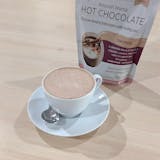I went to visit a friend who became a mum not too long ago. This was part of a gift pack I gave her and I think out of all the things in there, she was looking forward to trying this out the most. She's always been a big fan of organic ingredients so this was perfect.
We each made a cup after lunch. Even though the ingredients are geared towards postpartum support, I didn't hesitate to try some because the powder smelled delicious. For something that is dairy free, it tasted really good and soothing. It was a bit chilly that day so having this warm drink to sip on was perfect.
My friend really likes her food and drinks as organic and simple as possible, so the subtle sweetness of this suited her fine. She had hers with a bit of plant based milk. I added some sugar and milk to mine as well to elevate the taste. Really recommend this as a gift.
Got this for my wife and she loved it. She said it tasted great and is the perfect alternative for coffee for her. Recommended!
Beautiful natural ingredients. It is plant based, caffeine free and breastfeeding mum friendly. I the scent is earthy, fruity and faintly like liquorice. It tastes nice and comforting
Lovely tasting tea both hot and cold. I am not a lactating mother but I wanted this tea to drink for immune benefits and because it’s a refreshing taste. Looking forward to making it into a cold tea for hot summer days and the benefits that come with the quality ingredients.
I got this to try with a friend who was coming to visit. She's been trying to conceive so I thought if she liked it she could take it home with her.
It was great since it's caffeine free and my friend came over for dinner and we could have this tea afterwards and it wouldn't ruin our sleep. I'm not in the same situation as her (ie not trying to conceive) but I still found this tea enjoyable and easy to drink. We had it iced but you can drink it warm too. She did end up taking the rest with her and seemed to appreciate the gift. I hope it helps her.





